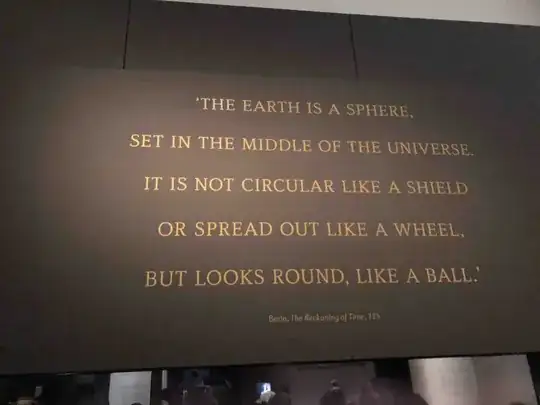According to historian James Hannam, the trope that the people in the Middle Ages believed that the Earth was flat was created in the 19th Century.
It is not difficult to see how the
story of Columbus was adapted so that
he became the figure of progress
rather than a lucky man who profited
from his error. According to Jeffrey Burton Russell here, the invention of
the flat Earth myth can be laid at the
feet of the nineteenth century writer
Washington Irving, who included it in
his historical novel on Columbus, and
the wider idea that the everyone in
the Middle Ages was deluded has been
widely accepted ever since.
The Real Flat Earthers
The myth that
Christians in the Middle Ages thought
the world was flat was given a massive
boost by Andrew Dickson White's
weighty tome The Warfare of Science with Theology published in 1896. This
book has become something of a running
joke among historians of science and
it is dutifully mentioned as a prime
example of misinformation in the
preface of most modern works on
science and religion. The flat Earth
is discussed in chapter 2 and one can
almost sense White's confusion that
hardly any of the sources support his
hypothesis that Christians widely
believed in it. He finds himself
grudgingly admitting that St Clement,
Origen, St Ambrose, St Augustine, St
Isodore, St Albertus Magnus and St
Thomas Aquinas all accepted the Earth
was a globe - in other words none of
the great doctors of the church had
considered the matter in doubt.
Although an analysis of what White
actually says suggests he was aware
that the flat Earth was largely a
myth, he certainly gives an impression
of ignorant Christians suppressing
rational knowledge of its real shape.
Here is the link that Hannam is referring to. In it Jeffrey Burton Russell writes:
In my research, I looked to see how
old the idea was that medieval
Christians believed the earth was
flat. I obviously did not find it
among medieval Christians. Nor among
anti-Catholic Protestant reformers.
Nor in Copernicus or Galileo or their
followers, who had to demonstrate the
superiority of a heliocentric system,
but not of a spherical earth. I was
sure I would find it among the
eighteenth-century philosophes, among
all their vitriolic sneers at
Christianity, but not a word. I am
still amazed at where it first
appears.
No one before the 1830s believed that
medieval people thought that the earth
was flat.
The idea was established, almost
contemporaneously, by a Frenchman and
an American, between whom I have not
been able to establish a connection,
though they were both in Paris at the
same time. One was Antoine-Jean
Letronne (1787-1848), an academic of
strong antireligious prejudices who
had studied both geography and
patristics and who cleverly drew upon
both to misrepresent the church
fathers and their medieval successors
as believing in a flat earth, in his
On the Cosmographical Ideas of the
Church Fathers (1834). The American
was no other than our beloved
storyteller Washington Irving
(1783-1859), who loved to write
historical fiction under the guise of
history. His misrepresentations of the
history of early New York City and of
the life of Washington were topped by
his history of Christopher Columbus
(1828). It was he who invented the
indelible picture of the young
Columbus, a "simple mariner,"
appearing before a dark crowd of
benighted inquisitors and hooded
theologians at a council of Salamanca,
all of whom believed, according to
Irving, that the earth was flat like a
plate. Well, yes, there was a meeting
at Salamanca in 1491, but Irving's
version of it, to quote a
distinguished modern historian of
Columbus, was "pure moonshine.
Washington Irving, scenting his
opportunity for a picturesque and
moving scene," created a fictitious
account of this "nonexistent
university council" and "let his
imagination go completely...the whole
story is misleading and mischievous
nonsense."
You can see Aquinas - who lived in the 13th Century - referring to the sun lighting up the "hemisphere" at Question 67 of the Summa Theologica, which is evidence that it was a commonplace understanding that the Earth was a sphere at that time. [Interestingly, Aquinas disputes that light is a body on the grounds that the movement of light cannot be discerned at large distances. His reasoning is impeccable; his measuring instruments were insufficient; his conclusion was wrong.]
In case the quotes from Aquinas seem too indirect, here is a far less indirect quote from a respected authority, Bede the Venerable, from more than 500 years earlier:
The Earth is a sphere, set in the middle of the universe. It is not circular like a shield or spread out like a wheel, but looks round, like a ball.
This plaque with that quote has been on open display in the British Library: 
Bede was a well known Benedictine Monk, teacher and scholar in 7th and 8th century Northumbria, known as "the father of English history" for writing Ecclesiastical History of the English People. He was very well known across Europe in his lifetime so it is unlikely that his view on the shape of the earth was unknown or aberrant for the time.
